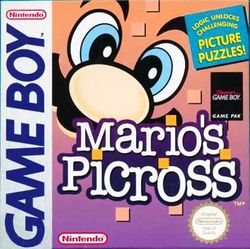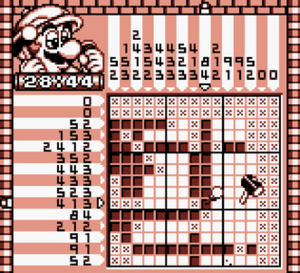Mario's Picross facts for kids
Quick facts for kids Mario's Picross |
|
|---|---|

European box art
|
|
| Developer(s) | Jupiter Ape |
| Publisher(s) | Nintendo |
| Series | Mario's Picross |
| Platform(s) | Game Boy |
| Release date(s) |
|
| Genre(s) | Puzzle |
| Mode(s) | Single player |
Mario's Picross is a 1995 puzzle video game for the Game Boy. Developed by Jupiter and Ape and published by Nintendo, it is a compilation of nonogram logic puzzles. The game stars Mario who chisels away at puzzle grids to form pictures. The game initially received positive reviews, with reviewers citing its length and addictive nature as a positive, but its grid sizes and absence of typical Mario elements as a negative.
Although the game sold well in Japan, the game flopped in English-speaking regions. As a result of this, the game was followed by two sequels, Mario's Super Picross and Picross 2, released only in Japan. The next Picross game published by Nintendo to be released in English-speaking regions would be Picross DS in 2007, twelve years later. Due to its limited sales, the game is somewhat of a cult classic. The game is also available on the Nintendo 3DS through its Virtual Console service.
Gameplay
In Mario's Picross, the player is presented with a puzzle grid (either 5 by 5, 10 by 10 or 15 by 15 spaces in size, depending on the difficulty chosen) that they must chisel at in accordance with the numerical hints provided on the upper and left-hand edges of the grid in order to reveal a picture. In addition to the ability to chisel spaces, the player is also able to mark spaces with a cross to signify that the space is not meant to be chiseled. The numbers present outside the grid tell the player how many spaces should be chiseled within the row or column it is next to; if a single number is present on the row or column, there is that number of required chiseled spaces within said row or column, while if more than one number is present on the row or column, there are those numbers of required chiseled spaces, but separated by an undetermined amount of blank spaces. The player must use these numerical hints to fill in the grid both vertically and horizontally. Similar to a crossword, when a row or column is filled in, it is able to give hints as to the nature of the rows or columns it intercepts.
The player is given thirty minutes to complete each puzzle. If the player incorrectly chisels a space, some of the remaining time is deducted; upon the player's first error, two minutes are deducted; upon the second, four minutes; upon the third, eight minutes. Mistakes succeeding the third continue deducting eight minutes. If the player runs out of time, Mario falls over, and the game is over. If the player finishes the puzzle, Mario makes a thumbs-up motion, and the final picture is shown, with a subtitle detailing what it is. Additionally, a "With Hint" option is available at the beginning of the puzzle. Choosing this will start a roulette with the numbers labelling the columns and rows. The player is able to semi-actively choose a row and a column to be pre-filled in. After a puzzle is complete, its time of completion is shown on the menu, as well as whether the player used the With Hint option.
Mario's Picross features a total of 256 puzzles, separated into four modes — "Easy Picross", "Kinoko", "Star" and "Time Trial" — with 64 in each. The Easy Picross, Kinoko and Star modes all follow the gameplay pattern aforementioned (increasing in difficulty), while Time Trial mode is untimed and does not show the player where they have made mistakes. If the player scores high enough, they will be able to insert their score by using their initials, much like an arcade game. Whilst the Easy Picross, Kinoko and Star modes are playable prior to beating the game, Time Trial mode is only playable when the other three modes have all been completed. The game also allows the player to select from a number of tracks to listen to while completing puzzles.
See also
 In Spanish: Mario's Picross para niños
In Spanish: Mario's Picross para niños


